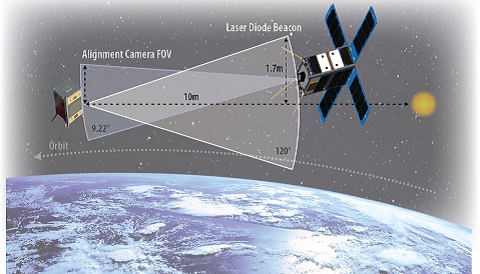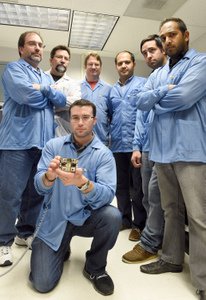An innovative CubeSat mission, slated to take to space this year, will demonstrate the feasibility of free-flying satellites.

NASA/Brittany Klein
An international team is seeking to field a unique pair of astronomy satellites later this year, a duo that will test free-flying coronagraphs for future missions.
The CANYVAL-X (CubeSat Astronomy by NASA and Yonsei using Virtual Telescope Alignment eXperiment) mission will feature a pair of small satellites flying as a tandem telescope, one carrying the optics and the other carrying the detector. Flying in formation allows one satellite to block a celestial target from the point of view of the other satellite. This coronagraph will enable astronomers to study objects close to a bright source, such as exoplanets near bright parent stars or the Sun's elusive corona.

NASA/Macallum
“CANYVAL-X is an engineering proof of concept,” says project manager Neerav Shah (NASA Goddard Space Flight Center). The mission's purpose is to test how precisely two independent satellites can be aligned in space.
Though missions such as the Solar Heliospheric Observatory have built-in coronagraphs, and other missions have demonstrated free-flying tandem capabilities, CANYVAL-X will perform a first in space: keeping two satellites aligned on a distant source while in motion. Such a feat isn't easy while moving at more than 4.5 miles per second in low-Earth orbit.
Paving the Way for Future Missions
“Any mission where you need to fly in tandem to gather a measurement would certainly benefit,” Shah said in a recent NASA Goddard press release. “If we demonstrate the concept, we will enable the next-generation of space telescopes.”
Built in partnership between NASA, South Korea's Yonsei University, and the Korea Aerospace Research Institute, the two CANYVAL-X satellites have been dubbed Tom and Jerry. Jerry is a 1U CubSat, 10 centimeters on a side (about the size of a grapefruit), while Tom consists of a 2U configuration (essentially two 1U CubeSats stacked together) that houses the camera. The mission will launch on a SpaceX Falcon-9 rocket from Vandenberg Air Force Base, California, along with several other CubeSat payloads and Taiwan's FORMOSAT-5 satellite. The launch is scheduled for May 2016.

NASA/KARI/Yonsei
As a proof of concept mission, CANYVAL-X will demonstrate key technologies for using free-flying coronagraphs in space, including micro-propulsion using millinewton thrusters, relative position sensing, and communications control between the two spacecraft. First conceived as the Virtual Telescope Demonstration Mission (VTDM), CANYVAL-X will observe the Sun on its planned three-month mission.
The Falcon-9 rocket will place CANYVAL-X in a sun-synchronous orbit around Earth so that the two tiny spacecraft, flying 10 meters (33 feet) apart, will constantly face the Sun as they carry out observations.
Though missions such as the upcoming James Webb Space Telescope and the Wide Field Infrared Space Telescope feature built-in coronagraphs, a free-flying version could offer much more. With a baseline hundreds of feet long, less light will "bleed over," diffracting around the occulting disk that blocks the star from view. That would enable sub-arcsecond resolution, so an accompanying detector could pick out details near the limb of the Sun or on close-in orbits around a distant star. A setup separated between two spacecraft could even vary in focal length by reducing or increasing the separation distance.
The idea of free-flying coronagraphs has been around for awhile. In fact, the 1975 Apollo-Soyuz Test Project (primarily designed to feature American-Soviet cooperation) featured an experiment that had the Soyuz observe the Sun as our star passed behind the Apollo spacecraft. But the resulting images were less than stellar.
Recently, technology has begun to catch up.The Swedish Space Corporation made some tentative steps in 2010 with its Prototype Research Instrument and Space Mission technology Advancement (PRISMA) satellites. And the European Space Agency's PROBA-3 (PRoject for On-Board Autonomy) spacecraft set to launch in 2018 will also feature a proof-of-concept solar coronograph composed of two satellites. Proposals for future missions that feature an independent coronagraph include the New Worlds Observer, an idea for an exoplanet-hunting mission.
In the meantime, you're likely to see some amazing images of the solar corona out of Indonesia during the only total solar eclipse of 2016. CANYVAL-X could pave the way for making such images routine.
 0
0









Comments
You must be logged in to post a comment.